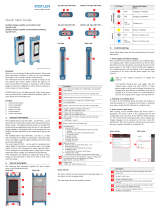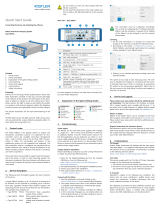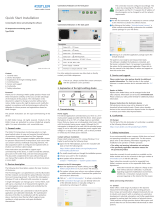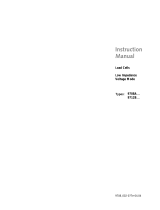Page is loading ...

Instruction
Manual
Engine Peak Meter
Type 2516B1/B12
ä
2516B1_002-888e-10.19

Instruction
Manual
Engine Peak Meter
Type 2516B1/B12
ä
2516B1_002-888e-10.19


Foreword
2516B1_002-888e-10.19 Page 1
Foreword
Thank you for choosing a Kistler quality product
characterized by technical innovation, precision and long
life.
Information in this document is subject to change without
notice. Kistler reserves the right to change or improve its
products and make changes in the content without
obligation to notify any person or organization of such
changes or improvements.
© 2019 Kistler Group. Kistler Group products are
protected by various intellectual property rights. For more
details visit www.kistler.com. The Kistler Group includes
Kistler Holding AG and all its subsidiaries in Europe,
Asia, the Americas and Australia.
Kistler Group
Eulachstraße 22
8408 Winterthur
Switzerland
Tel. +41 52 224 11 11
www.kistler.com

Content
Page 2 2516B1_002-888e-10.19
Content
1.
Introduction ................................................................................................................................................. 3
1.1The Kistler service ............................................................................................................... 4
2.
Important notes ........................................................................................................................................... 5
2.1General ................................................................................................................................ 5
2.2Hints on the use of these operating instructions ................................................................. 5
2.3Disposal of electronic equipment ........................................................................................ 5
3.
Description .................................................................................................................................................. 6
3.1Introduction ......................................................................................................................... 6
3.2Measuring functions ............................................................................................................ 6
3.3Functional principle ............................................................................................................. 7
3.4Measuring process .............................................................................................................. 9
3.4.1Zero shifter ............................................................................................................. 9
3.4.2The measurement ................................................................................................ 10
4.
Operation ................................................................................................................................................... 11
4.1Connections and control elements .................................................................................... 11
4.2Start-up .............................................................................................................................. 13
4.3Measurement with statistical evaluation of 1 ... 100 pressure cycles ............................... 14
4.4Segmentation of memory .................................................................................................. 14
4.5Measuring the instantaneous peak value ......................................................................... 15
4.6Recalling measured data stored ....................................................................................... 15
4.6.1Single measurement ............................................................................................ 15
4.6.2Overview pav ......................................................................................................... 16
4.7Deleting the memory ......................................................................................................... 16
4.8Data transfer with USB interface ....................................................................................... 16
4.9Measurand storage and output to USB interface .............................................................. 18
4.10Password........................................................................................................................... 19
5.
Sensors and adapter ................................................................................................................................ 20
6.
PC software ............................................................................................................................................... 21
7.
Maintenance and calibration ....................................................................................................................... 22
7.1Calibration Ex-Factory ....................................................................................................... 22
7.2Recalibration Engine Peak Meter Type 2516B1 ............................................................... 23
7.3Recalibration Sensor Type 6619AP35 .............................................................................. 23
7.4Recalibration Engine Peak Meter Type 2516B12 ............................................................. 24
8.
Technical data ........................................................................................................................................... 26
9.
Declaration of Conformity ........................................................................................................................ 28
Total Pages 28

Introduction
2516B1_002-888e-10.19 Page 3
1. Introduction
Please take the time to thoroughly read this instruction
manual. It will help you with the installation, maintenance,
and use of this product.
To the extent permitted by law Kistler does not accept
any liability if this instruction manual is not followed or
products other than those listed under Accessories are
used.
Kistler offers a wide range of products for use in
measuring technology:
Piezoelectric sensors for measuring force, torque,
strain, pressure, acceleration, shock, vibration and
acoustic-emission
Strain gage sensor systems for measuring force and
moment
Piezoresistive pressure sensors and transmitters
Signal conditioners, indicators and calibrators
Electronic control and monitoring systems as well as
software for specific measurement applications
Data transmission modules (telemetry)
Kistler also develops and produces measuring solutions
for the application fields engines, vehicles, manufac-
turing, plastics and biomechanics sectors.
Our product and application brochures will provide you
with an overview of our product range. Detailed data
sheets are available for almost all products.
If you need additional help beyond what can be found
either online or in this manual, please contact Kistler's
extensive support organization.

Engine Peak Meter Type 2516B1/B12
Page 4 2516B1_002-888e-10.19
1.1 The Kistler service
The world-wide Kistler customer service is available to
you for any specific questions you may still have after
studying these instructions, and is also competent to
advise you concerning problems relating to specific
applications.
Fig. 1: Engine Peak Meter Type 2516B12

Important notes
2516B1_002-888e-10.19 Page 5
2. Important notes
It is essential for you to study the following information,
compliance with which is for your personal safety, when
you are working with the Engine Peak Meter and which
will ensure long-term, fault-free operation of this engine
peak meter.
2.1 General
Check all equipment packaging for any transport
damage. Report any damage to the transporters and to
the authorized Kistler distributor.
2.2 Hints on the use of these operating instructions
We recommend you to read the entire operating
instructions carefully. However, if you are in a hurry and
already have experience with Kistler devices, you can
confine yourself to reading the specific information
needed.
We have attempted to give these instructions a clear
layout to make it easier for you to gain direct access to
the information you need. Please keep these operating
instructions in a safe place where you can retrieve them
at any time.
If you lose these instructions, please contact your Kistler
customer service and ask for an immediate replacement.
Naturally, we must reserve the right if necessary to alter
any details and instructions in this instruction manual
without prior notification. Any equipment modifications will
also result in changes to the instruction manual. In case
of doubt, contact your Kistler distributor for updating
facilities for your documentation.
2.3 Disposal of electronic equipment
Old electronic equipment must not be disposed of in
household waste. Please hand in old equipment to the
nearest electronic equipment disposal point or contact
your Kistler sales outlet.

Engine Peak Meter Type 2516B1/B12
Page 6 2516B1_002-888e-10.19
3. Description
3.1 Introduction
The Type 2516B… is a handy peak-pressure measuring
instrument for measuring the cylinder pressure of internal
combustion engines with a speed range of up to 4 000
1/min.
This battery-operated measuring instrument measures
between 1 … 100 pressure cycles, from which it
calculates the arithmetic mean value of the peak
pressure, standard deviation, steepest slope of the
pressure curve as well as the average pressure curve.
The numerical data are shown on the LC display and can
be saved as required. The average pressure curve can
be analyzed with the software contained in the included
accessories.
An additional measuring function allows the peak
pressure ("Peak") to be displayed without limitation of
time. The analog sensor signal always appears at the
monitor output.
3.2 Measuring functions
1. Statistical evaluation of 1 ... 100 pressure cycles
pmax maximum peak pressure
pmin minimum peak pressure
pav average peak pressure
psdev Standard deviation of the peak pressure
(dp/dca) max steepest slope of the pressure curve
Speed speed
2. Pressure curve (p-t)
Average pressure curve with a resolution of 720
measuring points per revolution, which can be printed
out via the USB interface (ASCII file). The pressure
curve can be displayed with the software provided.
Please note that the pressure curve has not been
recorded in relation to the crank angle. The scaling of
the x-axis in °crank angle has been selected only for
the purpose of providing a better illustration, where
360 measuring points represent 360 °KW. For a first
expertise the pressure curve can be displayed on the
display.

Description
2516B1_002-888e-10.19 Page 7
3. Instantaneous peak value "Peak"
The peak pressure is shown without limit of time. For
this application, we recommend use of the optionally
available plug-in power unit Art. No. 5.510.293.
4. Average value of the stored pav values.
The average value is calculated from the measurands
stored in Memory Block 1 pav and shown on the
display. For the purpose of calculating this value, it is
essential to store the measurements in ascending
sequence (Store to Memory 1 –> 20). If this is not
done, the error message "Error" will appear for the pav
value, while all other measurands will be shown
correctly.
3.3 Functional principle
The cylinder pressure is measured with a pressure
sensor such as Type 7613C… at the indicator valve of
the engine. Since long indicator tubes cause pipe
oscillations, which can falsify the measuring signal, the
cylinder pressure signal can be smoothed with an
adjustable low-pass filter. The rechargeable battery has a
operating time of about 4 hours. If the symbol
appears on the LCD display, the battery must be
Mean value of the
stored p
av
values

Engine Peak Meter Type 2516B1/B12
Page 8 2516B1_002-888e-10.19
recharged. The meter will switch off automatically 2
minutes after the last button actuation, provided this
function has not been deactivated (see chapter 4.2 Start-
up).
The Engine Peak Meter has ä-conformity according to
EC Directive 89/336/EEC and complies with EMC
standards for industrial and laboratory equipment
(interference emission EN 61000-6-3 and 4 respectively
as well as interference immunity EN 61000-6-2 and 1
respectively).

Description
2516B1_002-888e-10.19 Page 9
3.4 Measuring process
3.4.1 Zero shifter
The meter has a special Zero Shifter function, which
automatically sets the various quiescent voltages of the
connected sensors to a specific value = zero point. The
display will show "Wait" until this value is reached upon
which the display will show "Ready" and the meter will
then be ready to operate. If the "Measure" button is
pressed during "Wait", the measuring process will not
start. The button is operational only when "Ready"
appears.
After successful actuation of the measuring process, the
meter waits until the set trigger threshold of the pressure
signal is reached before it analyzes the selected number
of operating cycles.
Fig. 2: Measuring principle
The "Measure" button has been pressed before
the time t = 0, i.e. at time t = 0 the meter is
already synchronized with the engine speed.

Engine Peak Meter Type 2516B1/B12
Page 10 2516B1_002-888e-10.19
3.4.2 The measurement
After the "Measure" button has been pressed, a check is
made as to whether a pressure signal exists and whether
the trigger threshold has been reached. If this is the case,
the meter synchronizes with the engine, then determines
the period and from it the engine speed, and analyzes a
given number of combustion cycles according to the
settings selected in the menu.
Every second pressure curve is acquired for the
evaluation. The measurement is started by means of a
pre-trigger in the low pressure range (charge-air
pressure).
With a four-stroke engine, only the compression and
combustion strokes are recorded (first 360 ° of the
combustion cycle).

Operation
2516B1_002-888e-10.19 Page 11
4. Operation
4.1 Connections and control elements
Type 2516B1 Connections
Fischer KE103 connector for pressure sensor Type
6619AP35
BNC neg. connector for output of the analog sensor
signal
USB interface
2 pin Klinker connector (EIAJ standard) for external
12 V supply
Fig. 3: Connections Type 2516B1 Fig. 4: USB interface

Engine Peak Meter Type 2516B1/B12
Page 12 2516B1_002-888e-10.19
Control elements
On/Off Meter on/off switch
(Meter switches off after about 2 minutes of
non-use, provided this function has not been
deactivated (see chapter 4.2)
F1 ... F3 Function buttons; function is indicated on the
display
Menu To call up the menus:
Measurement Settings
Instrument Settings
Memory
a s To select a menu or change a parameter
Esc To exit the menu
OK To confirm entry
Measure To start a measurement

Operation
2516B1_002-888e-10.19 Page 13
4.2 Start-up
Once the meter on Type 2516B1 is turned on, the
software version is displayed.
The factory settings are as follows:
Settings in the "Measurement Settings" menu
Type 2516B1
Sensitivity 13 mV/bar
Engine 2-stroke
Pressure unit bar
Low-pass filter (5
th
order Butterworth) 300 Hz
Trigger Level 10 % FS
Measuring cycles 16
Settings in the "Instrument Settings" menu
Time hms
Date dmy
Auto off (turns off autom. after 2 min.) activated
Password deactivated
Default settings Resets
"Measuring
Setting"
parameters to
factory setting
"USB Settings"
Baud rate 19 200 Bd
The parameters set can be edited as follows:
1. Turn on the engine peak meter
2. Press the "Menu" button
3. Select the menu with the a s buttons:
Measurement Settings
Instrument Settings
Memory
USB Setting
4. Confirm with OK button
5. Select the parameter with a s button
6. Call up the parameter with the OK button, edit the
value with the a s buttons and confirm the new value
set with the OK button
7. Press the Esc button to return to a step in the menu
hierarchy.

Engine Peak Meter Type 2516B1/B12
Page 14 2516B1_002-888e-10.19
4.3 Measurement with statistical evaluation of 1 ... 100 pressure
cycles
1. Connect the sensor to the Engine Peak Meter
2. Connect the sensor to the indicator valve
3. Switch on the meter
4. Start the measuring process by pressing the
"Measure" button. The display shows "Measuring
running" followed by the number of pressure cycles to
be measured. On completion of the measurement, the
display shows the average peak pressure value "pav".
The measurands of the individual engine
characteristic can be called up with the a s buttons.
5. To save the measurement, press the "F2"="Store"
button. The display then shows:
Store to Memory
Memory Block
If the memory location shown is accepted, save the
measurands by pressing the "F2"="Store" button once
more.
If the measurement is to be assigned to a different
memory location, the number of the memory location
can be edited with the a s buttons. Selection of the
Memory Block can be edited with the "F3"="Toggle"
button. Save it by pressing the "F2"="Store" button.
4.4 Segmentation of memory
Memory Block 1
(Storage of the data sets 1 ... 20)
Memory Block 2
(Storage of the data sets 21 ... 40)
Memory 1
. .
. .
Memor
y
20
Memory 21
. .
. .
Memor
y
40

Operation
2516B1_002-888e-10.19 Page 15
4.5 Measuring the instantaneous peak value
1. Connect the sensor to the Engine Peak Meter
2. Connect the sensor to the indicator valve
3. Switch on the meter
4. Select the "Peak" display with the a s buttons. The
instantaneous peak value is now continuously
displayed, the reading on the display is updated at 1,5 s
intervals.
Important: Automatic off-switching must be
deactivated, otherwise the meter will be switched off
after 2 minutes. It is advisable to use the optionally
available plug-in power unit Art. No. 5.510.293 for
continuous monitoring.
The pressure signal is available as an unfiltered
voltage signal of 0 ... 5 V at the monitor output, in
which 0 Volt represents the lowest pressure value
(boost pressure).
4.6 Recalling measured data stored
4.6.1 Single measurement
1. Switch on the meter
2. Select "Read out one shot"
3. Press the "F1"="Read" button
4. Select the measurement you require with the a s and
"F3"="Toggle" buttons
5. The measured data from the stored measurements
are shown on the display. At the same time, the top
right area of the display shows the number of the
memory location and the memory block.
Mean value of the
stored pav values

Engine Peak Meter Type 2516B1/B12
Page 16 2516B1_002-888e-10.19
4.6.2 Overview p
av
1. Press the "F1" = "Read" button
2. Select "Read out all pav"
All pav of a memory block are shown. Switch from
Block 1 to Block 2 with "Toggle"
4.7 Deleting the memory
The entire memory contents can be deleted in the
"Memory" menu.
1. Switch on the meter
2. Press the "Menu" button
3. Menu selection: "Memory" with the a s buttons
4. Confirm with the "OK" button
Individual measurements cannot be deleted. However, it
is possible to overwrite existing measured data.
4.8 Data transfer with USB interface
The measurements stored are available as an ASCII file
and can be transferred via the serial interface to a PC.
Only the link cable Art. No. 5.590.303 contained in the
included accessories should be used for the data
transfer.
Before the data transfer, a check must be made to
determine whether the baud rate is the same as that of
the PC and if necessary it must be adjusted accordingly.
Transfer of data to the evaluation software included
should take place at a baud rate of 19 200 baud.

Operation
2516B1_002-888e-10.19 Page 17
Data transfer:
1. Switch on the meter
2. Press the "F3"="Send" button; the display will show:
" Send All Shots":
all stored data records are sent
" Send Memory x to: y":
x,y = 1 … 40, select with "OK" ; a s; <>"F2"
" Actual Shot":
last not yet stored measurement is sent
" Send with curve?":
NO / YES
First select with or without curve, then select which data
records are to be sent.
3. Press the "F3="Send" button to transfer the data
The serial number of the Engine Peak Meter Type
2516B1 is transmitted together with the measured data.
Example
Selection: Memory Block 2 data records 2 to 4
Meter entry: Send Memory 22 to 24
/










